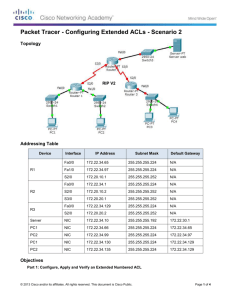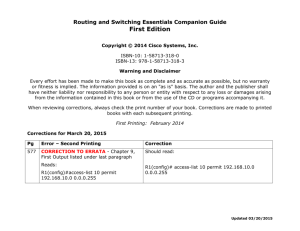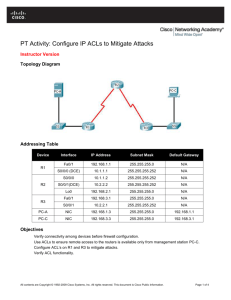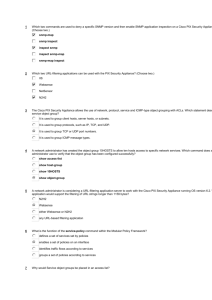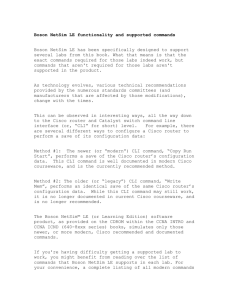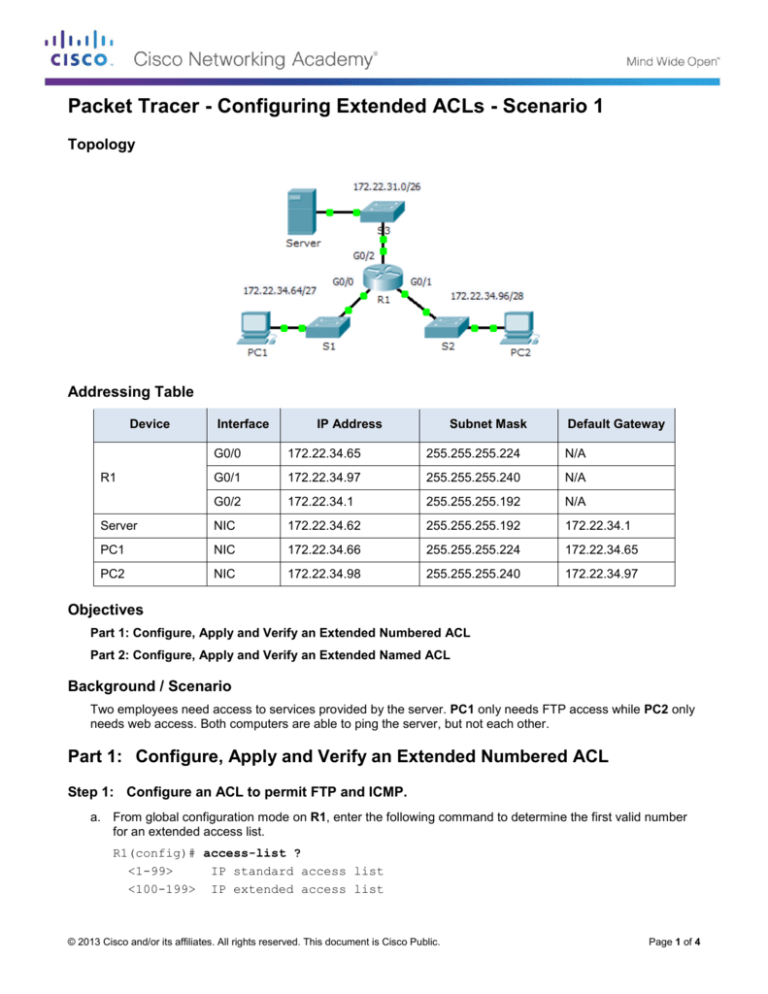
Packet Tracer - Configuring Extended ACLs - Scenario 1
Topology
Addressing Table
Device
Interface
IP Address
Subnet Mask
Default Gateway
G0/0
172.22.34.65
255.255.255.224
N/A
G0/1
172.22.34.97
255.255.255.240
N/A
G0/2
172.22.34.1
255.255.255.192
N/A
Server
NIC
172.22.34.62
255.255.255.192
172.22.34.1
PC1
NIC
172.22.34.66
255.255.255.224
172.22.34.65
PC2
NIC
172.22.34.98
255.255.255.240
172.22.34.97
R1
Objectives
Part 1: Configure, Apply and Verify an Extended Numbered ACL
Part 2: Configure, Apply and Verify an Extended Named ACL
Background / Scenario
Two employees need access to services provided by the server. PC1 only needs FTP access while PC2 only
needs web access. Both computers are able to ping the server, but not each other.
Part 1: Configure, Apply and Verify an Extended Numbered ACL
Step 1: Configure an ACL to permit FTP and ICMP.
a. From global configuration mode on R1, enter the following command to determine the first valid number
for an extended access list.
R1(config)# access-list ?
<1-99>
IP standard access list
<100-199> IP extended access list
© 2013 Cisco and/or its affiliates. All rights reserved. This document is Cisco Public.
Page 1 of 4
Packet Tracer - Configuring Extended ACLs - Scenario 1
b. Add 100 to the command, followed by a question mark.
R1(config)# access-list 100 ?
deny
Specify packets to reject
permit Specify packets to forward
remark Access list entry comment
c.
To permit FTP traffic, enter permit, followed by a question mark.
R1(config)# access-list 100 permit ?
ahp
Authentication Header Protocol
eigrp Cisco's EIGRP routing protocol
esp
Encapsulation Security Payload
gre
Cisco's GRE tunneling
icmp
Internet Control Message Protocol
ip
Any Internet Protocol
ospf
OSPF routing protocol
tcp
Transmission Control Protocol
udp
User Datagram Protocol
d. This ACL permits FTP and ICMP. ICMP is listed above, but FTP is not, because FTP uses TCP. So you
enter TCP. Enter tcp to further refine the ACL help.
R1(config)# access-list 100 permit tcp ?
A.B.C.D Source address
any
Any source host
host
A single source host
e. Notice that we could filter just for PC1 by using the host keyword or we could allow any host. In this case,
any device is allowed that has an address belonging to the 172.22.34.64/27 network. Enter the network
address, followed by a question mark.
R1(config)# access-list 100 permit tcp 172.22.34.64 ?
A.B.C.D Source wildcard bits
f.
Calculate the wildcard mask determining the binary opposite of a subnet mask.
11111111.11111111.11111111.11100000 = 255.255.255.224
00000000.00000000.00000000.00011111 = 0.0.0.31
g. Enter the wildcard mask, followed by a question mark.
R1(config)# access-list 100 permit tcp 172.22.34.64 0.0.0.31 ?
A.B.C.D Destination address
any
Any destination host
eq
Match only packets on a given port number
gt
Match only packets with a greater port number
host
A single destination host
lt
Match only packets with a lower port number
neq
Match only packets not on a given port number
range
Match only packets in the range of port numbers
h. Configure the destination address. In this scenario, we are filtering traffic for a single destination, the
server. Enter the host keyword followed by the server’s IP address.
© 2013 Cisco and/or its affiliates. All rights reserved. This document is Cisco Public.
Page 2 of 4
Packet Tracer - Configuring Extended ACLs - Scenario 1
R1(config)# access-list 100 permit tcp 172.22.34.64 0.0.0.31 host
172.22.34.62 ?
dscp
Match packets with given dscp value
eq
Match only packets on a given port number
established established
gt
Match only packets with a greater port number
lt
Match only packets with a lower port number
neq
Match only packets not on a given port number
precedence
Match packets with given precedence value
range
Match only packets in the range of port numbers
<cr>
i.
Notice that one of the options is <cr> (carriage return). In other words, you can press Enter and the
statement would permit all TCP traffic. However, we are only permitting FTP traffic; therefore, enter the
eq keyword, followed by a question mark to display the available options. Then, enter ftp and press
Enter.
R1(config)# access-list 100 permit tcp 172.22.34.64 0.0.0.31 host
172.22.34.62 eq ?
<0-65535> Port number
ftp
File Transfer Protocol (21)
pop3
Post Office Protocol v3 (110)
smtp
Simple Mail Transport Protocol (25)
telnet
Telnet (23)
www
World Wide Web (HTTP, 80)
R1(config)# access-list 100 permit tcp 172.22.34.64 0.0.0.31 host
172.22.34.62 eq ftp
j.
Create a second access list statement to permit ICMP (ping, etc.) traffic from PC1 to Server. Note that
the access list number remains the same and a specific type of ICMP traffic does not need to be
specified.
R1(config)# access-list 100 permit icmp 172.22.34.64 0.0.0.31 host
172.22.34.62
k.
All other traffic is denied, by default.
Step 2: Apply the ACL on the correct interface to filter traffic.
From R1’s perspective, the traffic that ACL 100 applies to is inbound from the network connected to Gigabit
Ethernet 0/0 interface. Enter interface configuration mode and apply the ACL.
R1(config)# interface gigabitEthernet 0/0
R1(config-if)# ip access-group 100 in
Step 3: Verify the ACL implementation.
a. Ping from PC1 to Server. If the pings are unsuccessful, verify the IP addresses before continuing.
b. FTP from PC1 to Server. The username and password are both cisco.
PC> ftp 172.22.34.62
c.
Exit the FTP service of the Server.
ftp> quit
© 2013 Cisco and/or its affiliates. All rights reserved. This document is Cisco Public.
Page 3 of 4
Packet Tracer - Configuring Extended ACLs - Scenario 1
d. Ping from PC1 to PC2. The destination host should be unreachable, because the traffic was not explicitly
permitted.
Part 2: Configure, Apply and Verify an Extended Named ACL
Step 1: Configure an ACL to permit HTTP access and ICMP.
a. Named ACLs start with the ip keyword. From global configuration mode of R1, enter the following
command, followed by a question mark.
R1(config)# ip access-list ?
extended Extended Access List
standard Standard Access List
b. You can configure named standard and extended ACLs. This access list filters both source and
destination IP addresses; therefore, it must be extended. Enter HTTP_ONLY as the name. (For Packet
Tracer scoring, the name is case-sensitive.)
R1(config)# ip access-list extended HTTP_ONLY
c.
The prompt changes. You are now in extended named ACL configuration mode. All devices on the PC2
LAN need TCP access. Enter the network address, followed by a question mark.
R1(config-ext-nacl)# permit tcp 172.22.34.96 ?
A.B.C.D Source wildcard bits
d. An alternative way to calculate a wildcard is to subtract the subnet mask from 255.255.255.255.
255.255.255.255
- 255.255.255.240
----------------=
0. 0. 0. 15
R1(config-ext-nacl)# permit tcp 172.22.34.96 0.0.0.15 ?
e. Finish the statement by specifying the server address as you did in Part 1 and filtering www traffic.
R1(config-ext-nacl)# permit tcp 172.22.34.96 0.0.0.15 host 172.22.34.62 eq www
f.
Create a second access list statement to permit ICMP (ping, etc.) traffic from PC2 to Server. Note: The
prompt remains the same and a specific type of ICMP traffic does not need to be specified.
R1(config-ext-nacl)# permit icmp 172.22.34.96 0.0.0.15 host 172.22.34.62
g. All other traffic is denied, by default. Exit out of extended named ACL configuration mode.
Step 2: Apply the ACL on the correct interface to filter traffic.
From R1’s perspective, the traffic that access list HTTP_ONLY applies to is inbound from the network
connected to Gigabit Ethernet 0/1 interface. Enter the interface configuration mode and apply the ACL.
R1(config)# interface gigabitEthernet 0/1
R1(config-if)# ip access-group HTTP_ONLY in
Step 3: Verify the ACL implementation.
a. Ping from PC2 to Server. If the pings unsuccessful, verify the IP addresses before continuing.
b. FTP from PC2 to Server. The connection should fail.
c.
Open the web browser on PC2 and enter the IP address of Server as the URL. The connection should be
successful.
© 2013 Cisco and/or its affiliates. All rights reserved. This document is Cisco Public.
Page 4 of 4

